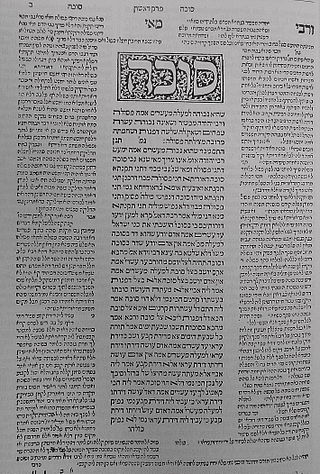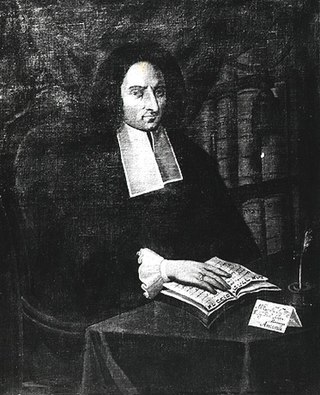Related Research Articles
Ovadia ben Jacob Sforno was an Italian rabbi, Biblical commentator, philosopher and physician. A member of the Sforno family, he was born in Cesena about 1475 and died in Bologna in 1549.
In Jewish law and history, Acharonim are the leading rabbis and poskim living from roughly the 16th century to the present, and more specifically since the writing of the Shulchan Aruch in 1563 CE.

Daniel Bomberg was one of the most important early printers of Hebrew books. A Christian Hebraist who employed rabbis, scholars and apostates in his Venice publishing house, Bomberg printed the first Mikraot Gdolot and the first complete Babylonian and Jerusalem Talmuds, based on the layout pioneered by the Soncino family printers, with the commentaries of Rashi, and of the Tosfot in the margins. The editions set standards that are still in use today, in particular the pagination of the Babylonian Talmud. His publishing house printed about 200 Hebrew books, including Siddurim, responsa, codes of law, works of philosophy and ethics and commentaries. He was the first Hebrew printer in Venice and the first non-Jewish printer of Hebrew books.
The history of responsa in Judaism, spans a period of 1,700 years. Rabbinic responsa constitute a special class of rabbinic literature, differing in form, but not necessarily in content, from Rabbinic commentaries devoted to the exegesis of the Bible, the Mishnah, the Talmud, and halakha. The codes themselves contain the rules for ordinary incidents of life. The responsa literature covers all these topics and more.
Isaac ben Abba Mari was a Provençal rabbi who hailed from Marseilles. He is often simply referred to as "Ba'al ha-Ittur," after his Magnum opus, Ittur Soferim.
Rabbi Samuel ben Moses de Medina, was a Talmudist and author from Thessaloniki. He was principal of the Talmudic college of that city, which produced a great number of prominent scholars during the 16th and 17th centuries. His teachers were the noted Talmudists Joseph Taitazak and Levi Ibn Chaviv, and among his schoolmates were Isaac Adarbi, Joseph ibn Leb, and Moses Almosnino. While on a mission to Constantinople he met the noted grammarian Menahem Lonzano, who studied under him for some time and who therefore speaks of him as his teacher.
Josef ben Isaac ibn Ezra was a Sephardic rabbi of the sixteenth and seventeenth centuries, descended from the Ibn Ezra family. Brought up in Salonica, he studied under Rabbi Samuel de Medina and became head of the Talmudic school there; among his pupils were Aaron Hazzan, Meir Melammed, and Shabbethai Jonah. Late in life he was a refugee in Constantinople, and then the rabbi of Sofia, where he died.
David ben Solomon ibn (Abi) Zimra (1479–1573) also called Radbaz (רַדְבָּ"ז) after the initials of his name, Rabbi David iBn Zimra, was an early Acharon of the fifteenth and sixteenth centuries who was a leading posek, rosh yeshiva, chief rabbi, and author of more than 3,000 responsa as well as several scholarly works.
Joseph Colon ben Solomon Trabotto, also known as Maharik, was a 15th-century rabbi who is considered Italy's foremost Judaic scholar and Talmudist of his era.
Jacob Ben Judah Weil, later known as Mahariv was a German rabbi and posek who as one of the Rishonim, was an active Talmudic authority during the first half of the fifteenth century.
Rabbi Yaakov Culi was a Talmudist and biblical commentator of the seventeenth and eighteenth centuries who died in Constantinople on August 9, 1732.
David Conforte was a Hebrew literary historian born in Salonica, author of the literary chronicle known by the title Ḳore ha-Dorot.
Meir ben Isaac Katzenellenbogen was a German rabbi born in Katzenelnbogen.

Simchah (Simon) ben Abraham Calimani was a Venetian rabbi and author. He was a versatile writer, and equally prominent as linguist, poet, orator, and Talmudist. During his rabbinate Calimani was engaged as corrector at the Hebrew printing office in Venice. Among the great number of books revised by him was the responsum of David ben Zimra (RaDBaZ), to which he added an index, and the Yad Ḥaruẓim of Gerson Ḥefeẓ, enriched with interesting notes of his own.

Isaac Lampronti was an Italian rabbi and physician, best known as author of the rabbinic encyclopedia Paħad Yitzħak.

Samson Morpurgo ben Joshua Moses was an Italian rabbi, physician, and liturgist.
The Castellazzo family was an Italian-Jewish family who settled at the beginning of the sixteenth century in Cairo, where several members occupied the rabbinate with distinction. The most important family members were the following:

Menahem Azariah da Fano was an Italian rabbi, Talmudist, and Kabbalist.
Aaron ben Joseph Sason was an Ottoman Talmudic author; born toward the middle of the sixteenth century, probably at Salonica, where he received his rabbinical education under the supervision of Mordecai Matalon, an eminent scholar. During the last decades of the sixteenth century Aaron ben Joseph engaged in teaching, and some of his pupils ranked among the eminent rabbis of Turkey. With these, as well as with his colleagues, he maintained a lively correspondence on Talmudic questions, the summary of which was published at Venice in 1625 under the title "Torat Emet". In the introduction to this work he mentions his commentaries on "Yad ha-Ḥazaḳah" of Maimonides and on the "Ṭur" of Jacob ben Asher, as well as his treatises on various halakic subjects, which do not appear to have been published, and which are perhaps altogether lost. It seems probable that the work "Sefat Emet", which, according to the testimony of Shabbethai, Bass, contains scholia to the Talmud and to the Tosafot, was written by Aaron ben Joseph and not by his grandson, Aaron ben Isaac Sason. This probability is supported to some extent by the title, "Sefat Emet," which corresponds with the title of his collection of responsa, as well as by the above cited statement in his introduction to "Torat Emet," that he had written scholia to the Talmud.

Ḥayyim ben Shabbethai, commonly known by the acronym Maharhash was a Sephardic rabbi and Talmudist, who is considered to be one of the great sages of Greek Jewry, serving as the Chief Rabbi of Thessaloniki, Greece.
References
 This article incorporates text from a publication now in the public domain : Singer, Isidore; et al., eds. (1901–1906). "Sforno". The Jewish Encyclopedia . New York: Funk & Wagnalls.
This article incorporates text from a publication now in the public domain : Singer, Isidore; et al., eds. (1901–1906). "Sforno". The Jewish Encyclopedia . New York: Funk & Wagnalls.